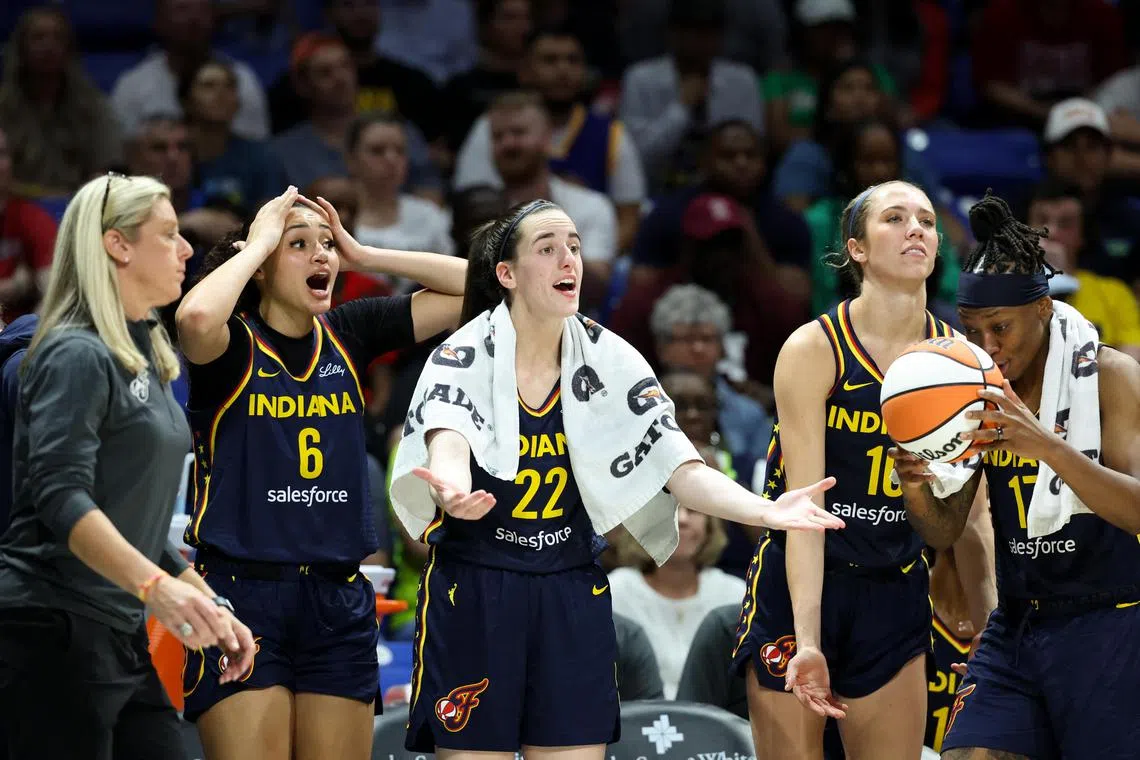WNBA is entering a new era: skyrocketing viewership, sold-out arenas, young stars
Sign up now: Get ST's newsletters delivered to your inbox

Indiana Fever guard Caitlin Clark (centre) during a pre-season game against the Dallas Wings at College Park Center on May 3.
PHOTO: REUTERS
Follow topic:
NEW YORK – Sue Bird hopes to sound like Charles Barkley one day.
The 43-year-old remembers listening to Barkley complain about his playing days on TNT’s Inside The NBA.
“He’s like, ‘Oh, I had to fly commercial. I didn’t have these charter flights’. Or, ‘Oh, these guys are making US$40 million (S$54 million). My contract was only US$10 million’. And he kind of sounds disgruntled,” Bird said.
Bird, who retired from the Women’s National Basketball Association (WNBA) after the 2022 season, cannot wait to toss out her own back-in-my-day tales.
“I’ve always joked, I hope I’m that disgruntled athlete because that means all the blood, sweat and tears was for something,” she said. “It means the game has grown.”
Bird has not been out of the league even two full years, but the league she will watch this year is already in a better place than it was when she quit playing.
Changes momentous and minute are aplenty as the 28th regular season began on May 14.
For years, as Bird and her generation of players graced the hardwood, the WNBA chipped away at areas of growth. But now the pace of the adjustments is explosive.
Television viewership numbers have skyrocketed across women’s basketball.
April’s draft averaged a record 2.45 million viewers, more than four times the 2023 figure, and it was the most-viewed WNBA telecast since 2000.
The first pre-season exhibition for Chicago Sky rookies Angel Reese and Kamilla Cardoso was not on traditional television, but more than 500,000 viewers tuned in to a phone stream from a resourceful fan. It seems like a harbinger of what will come in the regular season.
“The growth is happening so fast,” said Cheryl Reeve, the Minnesota Lynx’s coach and president for basketball operations. “It’s so accelerated. And I’ve been saying this in our own organisation that business as usual isn’t going to work any more.”
Early viewership returns reflect the strengthened link between the college and professional games.
The win by Cardoso and the South Carolina Gamecocks against Caitlin Clark and the Iowa Hawkeyes in April’s national championship game averaged 18.9 million viewers, making it the most watched women’s college basketball game ever. The tournament viewership was up 121 per cent from 2023.
With a high-profile rookie class entering the league, WNBA attendance is also already swelling. No team had ever sold out their season-ticket package in the off-season, but three teams (Las Vegas, Atlanta and Dallas) did in 2024.
Three games have also been moved to bigger venues to accommodate more fans who want to see Clark of the Indiana Fever play.
How players arrive at those contests will be changing as well. WNBA commissioner Cathy Engelbert recently announced that the league planned to add charter flights on a full-time basis this season.
Lynx guard Kayla McBride called this change “a breath of fresh air”. Minnesota forward Napheesa Collier noted that with more people watching women’s basketball, it was imperative to protect player privacy in public places.
Fever general manager Lin Dunn said Indiana were taking similar precautions to ensure that every member of her franchise would be safe. In addition to having a full security team at home games, the Fever will be travelling with multiple full-time security members on all trips, a team spokesperson said.
The travel adjustments demonstrate a commitment to improving player experiences, while new facilities provide another significant lift.
By season’s end, the Seattle Storm and the Phoenix Mercury will have opened new spaces.
The Storm debuted their 4,645 sq m performance centre in April, equipped with state-of-the-art strength and conditioning equipment, a health and wellness suite and an aquatics room. The Mercury’s centre is expected to open by the time they host the mid-July All-Star Game.
Expansion into new markets is also part of what is to come. A 13th franchise will begin play in the Bay Area in 2025, and a 14th team are reportedly set to debut in Toronto in 2026.
“We are witnessing a transformational moment in sports,” Engelbert said, “that we may not experience for generations.” NYTIMES

